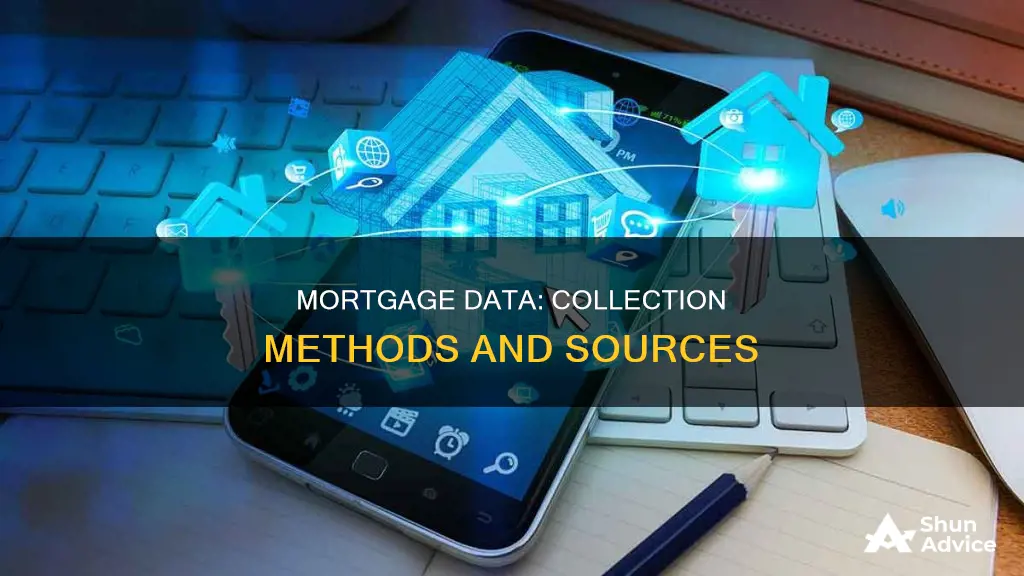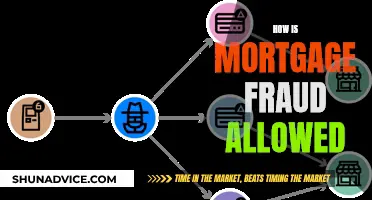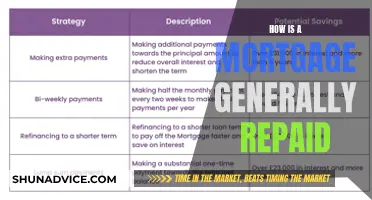
Mortgage data is critical to the lending process, and thousands of financial institutions are required to report it publicly each year under the Home Mortgage Disclosure Act (HMDA). This data includes information about the loan, property characteristics, applicant demographics, and the lender. Mortgage data capture solutions automate the collection and processing of information from mortgage documents, including borrower details such as name and address, property details such as address and value, loan terms, mortgage security, payment details, and escrow information. This data is used to determine a borrower's eligibility for a mortgage, calculate the loan amount and interest rate, and complete underwriting and risk assessment. Inaccurate or incomplete data can lead to errors, delayed closings, customer dissatisfaction, rejections, or even foreclosure.
| Characteristics | Values |
|---|---|
| Data Sources | Scanned documents, email, fax, mobile, and other sources |
| Pre-processing | De-skewing, noise reduction, document segmentation |
| Data Extraction | Optical character recognition (OCR), AI with machine learning, barcode recognition, mark sense recognition |
| Verification | Data consistency and completeness |
| Borrower Details | Name, Social Security Number, contact information, employment information |
| Property Details | Address, legal description, appraisal value, number of bedrooms/bathrooms, construction material |
| Loan Terms | Loan amount, interest rate, repayment term, fees, type, length |
| Mortgage Security | First or second lien, collateral |
| Payment Details | Payment schedule, payment amounts, penalties for late payments |
| Escrow Information | Taxes, insurance premiums |
| Prepayment Details | Penalties or fees for prepaying the mortgage |
What You'll Learn

Data extraction from mortgage documents
Manually keying in mortgage data is time-consuming, costly, error-prone, and risky. Inaccurate or incomplete data can lead to errors in the mortgage lending process, resulting in delayed closings, customer dissatisfaction, and even foreclosure.
To overcome these challenges, mortgage lenders are increasingly turning to mortgage data capture solutions that automate the process of extracting borrower and property details from documents. These solutions use technologies such as Optical Character Recognition (OCR), Artificial Intelligence (AI), machine learning, barcode recognition, and mark sense recognition to extract relevant data fields such as the borrower's name and address.
OCR is an automation technology that distinguishes individual characters in documents and converts them into machine-readable text for easy sharing, analysis, and further processing. It plays a pivotal role in enhancing the accuracy and speed of AI mortgage processing. AI algorithms, in combination with OCR, can recognize and interpret mortgage documents, extracting relevant information from text documents, scans, images, and other data formats.
Some popular tools in this space include Google Cloud Document AI, which offers powerful AI-based solutions, and Docsumo, which provides an intelligent OCR API with over 99% field-level accuracy.
Mortgage Borrowing: When Is It Too Much?
You may want to see also

Data capture solutions
Mortgage data capture solutions are designed to automate the process of collecting, processing, and routing information from mortgage documents. This helps to streamline the lending process, mitigate potential risks, and ensure data accuracy. The data captured from mortgage documents includes:
- Borrower details: Name, Social Security Number, contact information, and employment information.
- Property details: Address, legal description, and appraisal value.
- Loan terms: Loan amount, interest rate, repayment term, and any associated fees.
- Mortgage security: First or second lien and any collateral used to secure the loan.
- Payment details: Loan payment schedule, payment amounts, and penalties for late payments.
- Escrow information: Taxes or insurance premiums collected and held by the lender.
- Prepayment details: Any penalties or fees for prepaying the mortgage.
The input phase of the data capture process involves aggregating data from various sources, such as scanned documents, emails, faxes, and mobile devices. Pre-processing techniques like de-skewing, noise reduction, and document segmentation are then applied to ensure the data is clean and ready for extraction. Relevant data fields are extracted using optical character recognition (OCR), artificial intelligence (AI) with machine learning, barcode recognition, and other technologies. To ensure data accuracy, verification rules are applied, such as checking for consistency and completeness.
Mortgage data capture solutions offer several benefits over manual data entry, which is costly, time-consuming, error-prone, and risky. Automating the data capture process improves efficiency, reduces errors, and enables lenders to make more informed decisions. It also helps protect applicant and borrower privacy, which is critical in the mortgage industry.
Salary vs. Bonus: What Lenders Focus on for Mortgages
You may want to see also

Interest rates
Mortgage rates can vary depending on the loan term and type, and lenders determine interest rates based on several factors, including the borrower's credit score, debt-to-income (DTI) ratio, and the size of their down payment. By comparing loan offers from multiple lenders, borrowers can increase their chances of obtaining a competitive interest rate. Websites like Bankrate provide tools to compare interest rates from various lenders, helping borrowers find the best option for their needs.
The Home Mortgage Disclosure Act (HMDA) plays a significant role in collecting and disclosing mortgage interest rate data. This Act requires financial institutions to maintain, report, and publicly disclose loan-level information about mortgages. The data collected through HMDA helps shed light on lending patterns, identifies potential discriminatory practices, and provides insights into the housing needs of communities.
Mortgage interest rates are also influenced by the market conditions and the performance of stocks. During periods of market chaos or stock market volatility, mortgage rates may benefit and move lower. On the other hand, certain events, such as tariff policies, can create uncertainty and impact interest rates.
It is important to note that mortgage rates are subject to constant change, and predictions about their future direction may not always hold true. Borrowers and lenders need to stay updated with the latest rates and market trends to make informed decisions. By regularly monitoring interest rates and comparing offers, individuals can make more strategic choices when it comes to obtaining a mortgage or refinancing an existing one.
The Mortgage Appraisal Process: How It's Done
You may want to see also

Loan terms
The length of the loan, or loan term, is another vital aspect of loan terms. Mortgages can vary significantly in duration, with residential loans typically offered over 15 or 30 years, while commercial real estate loans may span a diverse range of periods, including short-term construction loans of around three years. The loan origination date, marking the commencement of the mortgage, is essential for understanding when the loan is expected to mature. This maturity date signifies the point at which the loan should be fully repaid, unless refinanced beforehand.
Interest rates are a pivotal component of loan terms, influencing the overall cost of the loan for the borrower. Lenders may offer varying interest rates, and understanding these rates is crucial for borrowers seeking the most favourable terms. The specific loan type further defines the loan terms and can include nuances such as fixed-rate or adjustable-rate structures.
Additionally, the identity of the lender is an important consideration within loan terms. This can include traditional banks, credit unions, or other entities with sufficient capital. The lender's profile provides insights into their typical deals and interest rates, indicating the potential for repeat business or a preference for more favourable terms.
Mortgage Deduction: A Crucial Financial Strategy for Homeowners
You may want to see also

Borrower details
When applying for a mortgage, lenders will request a variety of documents to assess the borrower's financial situation and ability to make payments on time. The specific details and documents required may vary depending on the borrower's financial circumstances and the lender's policies. However, here are some common borrower details that may be collected during the mortgage application process:
Income Verification
Lenders typically request documents such as recent pay stubs, W-2 forms, and tax returns to verify the borrower's income. They may ask for one to two years' worth of tax returns to ensure consistent annual income and stable employment. This information helps lenders gauge the borrower's ability to make regular mortgage payments.
Credit History and Scores
Lenders often pull credit reports with the borrower's permission. Credit history and credit scores play a crucial role in determining the borrower's eligibility for different types of mortgage loans. For example, conventional loans typically require a FICO® score of at least 620, and a higher score may be necessary for more competitive interest rates.
Down Payment and Reserves
Lenders will assess the borrower's ability to afford a down payment. A higher down payment is generally viewed favourably by lenders as it demonstrates financial stability. Lenders may also request to see bank statements to ensure that the borrower has sufficient funds in their account, including emergency reserves to cover several months' worth of mortgage payments.
Debt-to-Income Ratio
The borrower's debt-to-income ratio is another critical factor. Lenders typically look for a ratio below 43%, indicating that the borrower's debt obligations are not excessive relative to their income. This calculation helps lenders assess the borrower's ability to comfortably take on a mortgage while managing their existing debts.
Personal Information
Basic personal information about the borrower is also collected, including their name, contact information, and, in some cases, their address. This information is necessary for communication, loan processing, and record-keeping purposes.
Homeowners Insurance (HOI) and Property Taxes
Lenders also consider the costs associated with homeowners insurance (HOI) and property taxes. HOI is required by lenders to protect the physical property as it secures the mortgage. Lenders may collect HOI and property tax payments through an escrow account, ensuring that these expenses are covered on time.
Amerisave Mortgage: A Comprehensive Review of Their Services
You may want to see also
Frequently asked questions
The Home Mortgage Disclosure Act (HMDA) requires financial institutions to maintain, report, and disclose loan-level information about mortgages. This data is made public and helps determine whether lenders are serving the housing needs of their communities.
Mortgage documents contain a lot of information, including borrower details (name, Social Security Number, contact information, and employment information), property details (address, legal description, and appraisal value), loan terms (loan amount, interest rate, repayment term, and any associated fees), mortgage security, payment details, escrow information, and prepayment details.
Mortgage data capture solutions automate the collection of mortgage data. These solutions aggregate data from various sources, such as scanned documents, emails, and mobile, and then perform pre-processing to ensure data cleanliness. Relevant data fields are then extracted using technologies like optical character recognition (OCR) and artificial intelligence (AI). Finally, verification rules are applied to ensure data accuracy.
Mortgage loan data is used by lenders and mortgage professionals to make informed business decisions. It is also the baseline for property and casualty insurance policies, helping to create insurance quote estimations. Additionally, this data is used to determine a borrower's eligibility for a mortgage, calculate loan amounts and interest rates, and assess risk.







